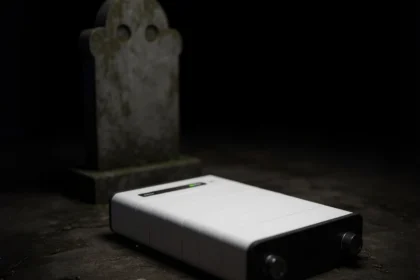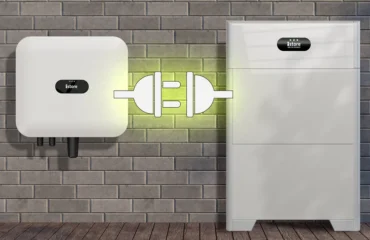
Solar is fantastic…until the sun goes down! That’s where a solar battery comes in.
If you already have a solar battery, you may be wondering when it’s time for a new one. Or perhaps you’re investigating going solar and all that involves. Before you buy a solar battery, there is an important question to answer: how long do solar batteries last?
Investing in a solar battery means investing in years of energy storage, so it’s worth knowing what you’re getting for your money.
Let’s unpack how long solar batteries last, what wears them out, and how to stretch every dollar of value from your battery.
What Is a Solar Battery?
Solar panels can generate more electricity than your home uses in a day. Instead of returning unused solar energy to the grid, a solar battery stores it for later use when the sun isn’t shining, like at night or on cloudy days. It can also kick in during blackouts or when energy prices spike, keeping the lights on and costs down.
A solar battery gives you more control over your power usage, reduces your home’s reliance on the grid, and saves you money on electricity bills.
What Is the Average Lifespan of Solar Batteries?
Most solar batteries last between five and 15 years.
The exact lifespan of a battery depends on several key factors.
Factors That Affect Solar Battery Lifespan
Battery Type
Lithium-ion solar batteries are the most common option used in Australian homes. They tend to last longer, often around 10 to 15 years. They’re more efficient, hold charge better, and cope well with daily use without wearing out too quickly.
Lead-acid batteries are an older style. They’re cheaper upfront, but usually only last three to seven years. They also need more maintenance and don’t handle frequent charging and discharging as well as lithium-ion batteries.
Depth of Discharge (DoD)
Depth of Discharge (DoD) refers to how much of your battery’s stored energy your home uses before the battery starts recharging from your solar panels. For example, if a battery has a 90% DoD, you can use up to 90% of its stored energy before it starts recharging.
Regularly using a large portion of stored energy or draining the battery close to empty puts extra strain on it. That wear and tear adds up and can shorten the battery’s lifespan.
Choosing a battery with a high recommended DoD, like many lithium-ion models, helps you get more usable energy and life from it.
Usage Patterns
How often your solar battery charges and discharges (fills up with energy and then powers your home) each day plays a big role in how long it lasts. Each full round of charging and discharging is called a cycle.
Most batteries can handle thousands of these cycles, but heavy daily use can wear them out faster. If your system is set up so the battery constantly charges during the day and almost entirely drains at night, it will age quicker than one used more gently.
The fewer full cycles your battery goes through each day, the longer it’s likely to last. That’s why having the right-sized system for your energy needs can make a real difference over time.
Temperature and Climate
Solar batteries don’t like extreme heat or cold. High temperatures can age a battery faster and reduce how much charge it can hold, while freezing weather can slow performance and efficiency.
Most systems work best in mild, stable conditions. You should install your battery in a spot protected from harsh weather, like a garage, under a shade, or in a weatherproof cabinet.
Maintenance
Regular inspections and proper maintenance of a solar battery can identify minor issues before they become big problems. Check for dust, corrosion, or any warning lights on the system.
Some batteries are low-maintenance, especially lithium-ion types, but it’s still worth giving them a quick check every so often and booking a professional service yearly.
How to Maximise the Lifespan of Solar Batteries
- Avoid Overcharging/Deep Discharging: Use built-in battery protection settings or a battery management system (BMS), a tool that controls how your battery charges and discharges. These systems help prevent overcharging or draining the battery too low.
- Choose a Battery Compatible With Your Solar Inverter: Your solar battery must be compatible with your system’s solar inverter. A mismatch can lead to inefficient charging and unnecessary strain on the battery.
- Control the Temperature: Install your battery in a shaded, well-ventilated outdoor area or indoors if possible. Avoid places with extreme heat or cold, as temperature swings can damage the battery.
- Keep Up With Regular Maintenance: Check for dust, loose wires, corrosion, and system alerts every few months. Book a yearly inspection with a solar technician to keep everything in good shape.
- Use Smart Monitoring Tools: Devices like iStore’s WLAN dongle let you track battery performance, usage, and health in real time, so you can catch issues early and manage your energy more efficiently.
When Should You Replace a Solar Battery?
Even the best solar batteries wear out. Look out for these signs that it might be time for a replacement.
- Shorter Backup Time: If your battery doesn’t power your home as long as it used to, it may be losing capacity.
- Slower Charging: If the battery takes much longer to charge fully, that’s a red flag.
- Unusual Noises and Overheating: Strange sounds and excessive heat can mean something’s wrong internally.
- Warning Lights or Error Messages: Your system may alert you when the battery isn’t performing properly.
- Battery Age: If your battery is 10–15 years old, it could simply be reaching the end of its natural lifespan, even if it’s still working.
How Much Do Solar Panel Batteries Cost?
Many factors influence the cost of replacing a solar battery.
- Size: Bigger batteries (measured in kWh) cost more.
- Type: Lithium-ion batteries last longer and perform better, but cost more than older lead-acid models.
- Brand: Well-known brands come at a premium.
- Installation Complexity: Replacing or adding a battery to an existing system may require extra parts or electrical work, which adds to the cost.
- Your Location: Labour and transport costs vary. Remote or regional areas may face higher charges than metro areas.
- Extra Features: Batteries with blackout protection, smart home integration, or advanced monitoring tools usually cost more.
- Government Rebates: From July 2025, the Australian Government’s Cheaper Home Batteries Program will offer a 30% discount on eligible home batteries. Extra rebates may apply in some states.
Replacing a solar battery can generally cost between $8,000 and $14,000. For example, installing a 5 kWh battery can cost around $8,700, while installing a 15 kWh battery can cost approximately $13,550.
Why Choose iStore Solar Batteries?
Durability: Tough Tech, Built to Last
iStore solar batteries can easily handle Australia’s tough and varied climate, operating reliably in temperatures from -20°C to 55°C.
They use lithium iron phosphate (LiFePO₄) technology, which is known for its stability, safety, and long lifespan. This type of battery chemistry resists overheating, supports thousands of charge cycles, and degrades more slowly, making it one of the most durable options on the market.
Safety: Self-Protecting for a Safer Home
Our lithium iron phosphate batteries have four layers of built-in protection.
- Stable Battery Chemistry: Lithium iron phosphate (LiFePO₄) is a safer, heat-resistant battery that’s far less likely to overheat or catch fire.
- Smart Monitoring System: A built-in Battery Management System (BMS) with eight temperature sensors helps prevent overcharging, deep discharging, and overheating by automatically adjusting battery activity.
- Automatic Fire Suppression: Each battery module has a self-activating fire extinguisher that kicks in within seconds if overheating is detected.
- Weatherproof Casing (IP66 Rated): Dustproof and water-resistant housing protects the battery from rain, dirt, and extreme weather, making it safe for outdoor use.
Modular Design: Add More Power, Anytime
Each iStore solar battery is a stackable module weighing 50 kg, with a capacity of 5 kWh (kilowatt-hours). You can connect up to six modules to increase storage to a maximum capacity of 30 kWh.
Wondering how many batteries your home will need? The average Aussie home with four people uses around 20 kWh of electricity daily, which equates to four battery modules (20 kWh total capacity).
With our modular battery design, you’re not stuck with your original setup if your energy needs change later. If your family grows, you buy an electric car, or add a granny flat to your property, you can easily upgrade your battery system to keep up with the extra energy demand without replacing the entire system.
Warranty: We’ve Got Your Back
iStore solar batteries come with a 10-year performance warranty, guaranteeing reliable storage and consistent performance for years to come.
This warranty is not just peace of mind and a safety net; it’s a sign that at iStore, we back our technology to go the distance in Aussie conditions.
FAQs
How Long Do Solar Panel Batteries Last?
Most solar panel batteries last between five and 15 years, depending on the type, how they’re used, and how well they’re maintained.
How Long Do Lithium-Ion Solar Batteries Last?
Lithium-ion solar batteries typically last 10 to 15 years, thanks to their high efficiency and ability to handle regular use.
How Long Does a Solar Battery Last at Night?
It depends on your battery size and how much power your home uses, but most solar batteries can run a household for several hours to overnight on a full charge.
For example, a 10 kWh solar battery can power a home for 8–14 hours at night.
What Factors Affect the Lifespan of Solar Batteries?
- Battery Type: Lithium-ion batteries usually last longer than lead-acid ones due to better efficiency and durability.
- Usage Patterns: Using a lot of stored energy daily can put more strain on the battery and cause it to wear out sooner.
- Depth of Discharge: The more energy you regularly use from the battery, the more strain it takes over time.
- Temperature: Extreme heat or cold can reduce the battery’s performance and lifespan.
- Maintenance: Regular checks and proper care prevent damage and keep the battery running smoothly for longer.
Can Solar Batteries Be Repaired?
Solar technicians can often repair common battery issues like connection faults, software glitches, and cell balancing problems. You don’t always need a complete battery replacement.
However, if the battery is badly degraded or damaged from age, overheating, or poor maintenance, replacing it is usually the more cost-effective option.
How Much Does It Cost to Replace a Solar Battery?
Replacing a solar battery can cost between $8,000 and $14,000, depending on the battery’s capacity, brand, and installation requirements. For example, a 5 kWh battery can cost around $8,700 installed, while a 15 kWh battery can cost approximately $13,550 installed.
Starting from July 1, 2025, the Australian Government’s Cheaper Home Batteries Program will offer a 30% discount on the upfront cost of installing eligible small-scale batteries, significantly reducing replacement expenses.
Additional state and territory rebates may further lower costs, so check local programs for potential savings.
Invest in Long-Lasting Solar Batteries with iStore </h2>
If your current solar battery is showing signs of slowing down, or you’re considering switching your home to solar power, you’re likely asking: “How long do solar batteries last?”
The answer to this question will help you choose a battery that suits your long-term energy needs, budget for upfront costs, and plan for future replacements.
Where can you find reliable, durable, and safe solar batteries? And solar inverters that work seamlessly with them?
At iStore! Browse our solar battery and solar inverter range today, then get in touch for a consultation or quote by calling 1300 515 640 or filling out this online form.




